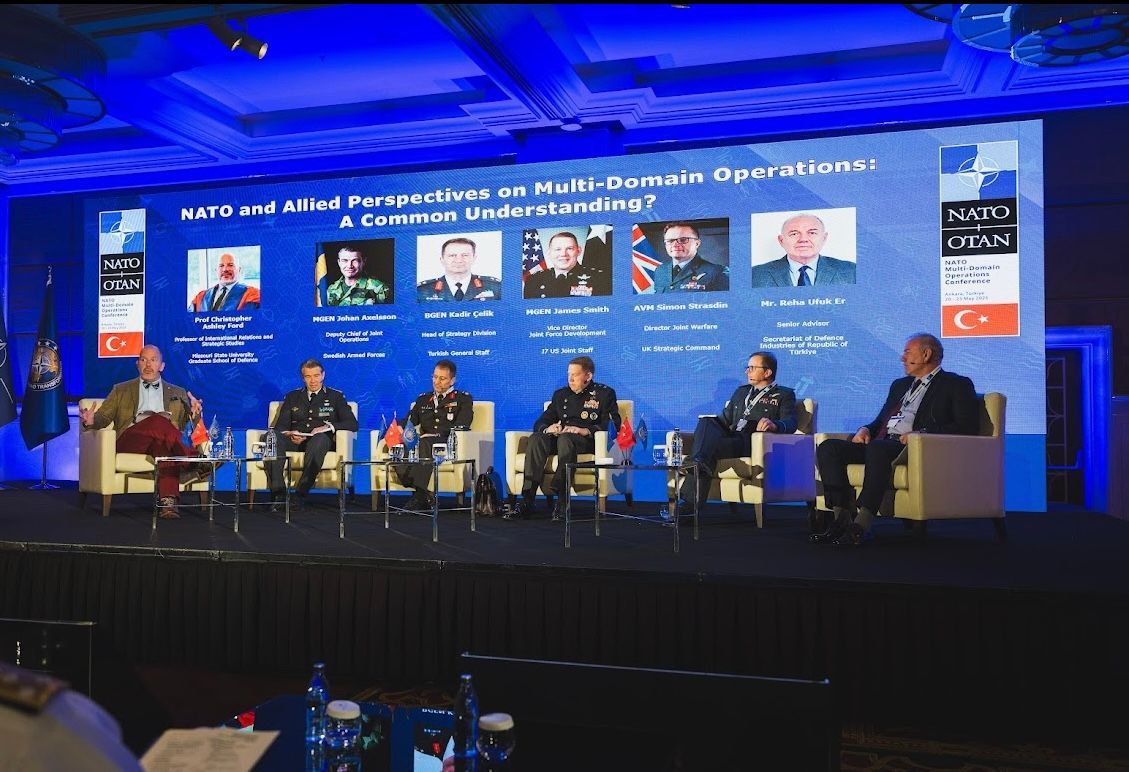Rules, Norms, and Community: Arms Control Discourses in a Changing World
Below appear the remarks Assistant Secretary Ford delivered to the European Union Conference on Nonproliferation in Brussels, Belgium, on December 13, 2019.
Good morning, everyone. It is a pleasure to attend this conference once again, and I thank you for having me.
Rather than give you just another conference event run-down of talking points and policy exhortations, I thought I would take the opportunity today to discuss some big-picture conceptual themes in the arms control arena — at least as I see them from my current role in exercising the delegated authorities of the United States’ Under Secretary of State for Arms Control and International Security.
In particular, I’d like to explore the distinctive roles and characteristics of two very different modes of arms control discourse. One approach is a much more traditional way of thinking about controlling the risks of potentially dangerous technologies, while the other is less traditional, but is nonetheless one that has been developing by leaps and bounds in recent years as the international community has struggled with rapid and portentous changes in our technological environment.
I. Regulatory Versus Normative Discourse
The first of these is what I think of as the “traditional” approach. This discourse is prohibitory and regulatory. It aspires to work on the basis of bright-line distinctions and categories — binary oppositions such as “legal versus illegal” or “compliance versus noncompliance” — and it can generally be thought of as a system of “hard” rules. It also tends to be very focused upon states and, in arms control applications, upon regulating the availability of things: specifically, certain technological tools capable of creating powerfully disruptive effects. Most of us are familiar with this approach as a result of its prominence in longstanding arms control and disarmament policy debates. Let’s call this the “regulatory” or “legal-regulatory” discourse.
The second discourse is a more fluid, more socially-constituted approach that seeks to establish and maintain norms and standards of responsible behavior, but that eschews much of the “hard” prescriptivism of traditional thinking. It is more about setting collective expectations than imposing rigid prohibitions, more about eliciting agreement upon and encouraging congruence with behavioral guidelines than about flatly “outlawing” anything, and more concerned with the effects of specific behavioral choices about what to do with potentially problematic things than with those thingsthemselves. It also does not require that all participants be of like kind (i.e., states), for it can work when its doors are opened not merely to states but to any relevant stakeholder. Let’s call this “normative” discourse.
These approaches are not exactly antitheses of each other, or in opposition. Indeed, it’s not even clear that at the most fundamental level they are even entirely distinct from each other at all, since given the international community’s lack of the law enforcement, judicial, and corrective institutions that exist in the domestic legal context, both of these arms control discourses rely — at the end of the day — upon community cohesion for their effectiveness. Indeed, certain norms regarding acceptable state behavior may even be codified in legal-regulatory instruments. Nevertheless, I do think they are different enough in their focus and operation to merit analytically separate treatment, and their comparison is instructive.
More significantly, from a policymaker’s perspective, these two approaches are not mutually exclusive, and indeed may be able to complement each other. But they are in important ways different paradigms, and I worry that their differences, and the circumstances in which they can be useful, are not well enough understood in policy community circles.
II. Normative Diplomacy
Most of us, I would imagine, are familiar with the traditional, legal-regulatory approach to arms control. It is the discourse underlying such instruments as the New START strategic offensive arms control agreement between the United States and Russia, and the Comprehensive Nuclear Test Ban Treaty (CTBT).
Fewer non-experts, however, may recognize how important the other discourse is — that is, the normative framework. Yet there are today multiple examples of how countries are working together to develop, articulate, and encourage behavior consistent with frameworks of responsible state behavior, taking a somewhat different approach to positively shaping the international security environment than does traditional arms control.
A. Cyberspace Challenges
One of these areas of ongoing normative development is cyberspace. No one here today needs me to tell them about the ways in which connectivity through and activity in cyberspace ties us all together in unprecedented ways and enriches the lives of all mankind. Nor do you need me to emphasize how, for that very reason, malicious activity in cyberspace holds the potential to cause untold chaos. Making things even more complicated, the cyber arena is not only a potential area for inter-state conflict but also an arena in which a bewildering variety of non-state actors operate on a day-to-day basis, including not merely businesses and private citizens but also terrorists and criminals. In this arena, incidents below the level of armed conflict occur with alarming frequency.
(1) Regulatory Arms Control Failure
Some states have tried to promote burdensome regulatory approaches to arms control in cyberspace — and not always with good intentions. I’ve been warning for a long time that we should watch out for disingenuous efforts to subject cyberspace to a regulatory-style framework on the basis of skewed understandings that threaten to turn cyber arms control into a tool autocratic regimes can use to suppress freedom of speech and expression — particularly speech critical of such regimes. And indeed, with Russian officials having taken the position that states need to prevent “socially dangerous action” in “information space” – and that free expression needs to be subject to “certain restrictions” to protect “public order,” “morals,” and respect for “reputations” – this seems to be precisely what they have in mind.
Thankfully, however, efforts have been underway for some years to develop alternative, less malevolent, and more genuinely effective ways to approach cyber challenges. Such a strategy was needed. We have not wanted to stymie the growth of this revolutionary technology, but we also want to ensure that States understand that they are expected to behave responsibly in cyberspace and the international community will rally against irresponsible behavior.
The availability of a different approach is important because traditional arms control also makes little sense in the cyber arena. This is, in part, because cyber “weapons” exist in private sector and other non-state actors’ hands as well as in the hands of states themselves, but also because of the fast moving nature and physical insubstantiality of the technology in question. It is no simple thing to bring novel weapons within traditional arms control frameworks even when you’re talking about intercontinental delivery systems that are the exclusive and jealously-guarded prerogative of sovereign states, which take years to develop and field, and which have reasonably clear physical signatures and are frequently intentionally displayed in public. (Of all the dangerous new strategic delivery systems currently being developed by Russia, for instance, only two are likely to be brought within the New START framework, while three others – Moscow’s bizarre Poseidon nuclear-powered and nuclear-armed underwater drone, the Kinzhal air-launched ballistic missile, and the appallingly irresponsible “flying Chernobyl” of the Burevestnik nuclear-powered cruise missile also known by its NATO reporting name of Skyfall – do not meet existing New START weapons definitions and will not be accountable under the treaty’s central limits.)
It is easy to see why no one has ever yet proposed an effective way in which traditional arms control could fully handle cyber weapons — which often consist merely of software, can be held as easily in non-state as in state hands, and are carefully concealed prior to deployment in order to protect coding secrets and target vulnerabilities, and can be created, replicated, stored, or transmitted almost anywhere, by anyone, at any time. Moreover, the pace of innovation is such that any negotiated agreement purporting to control specific cyber tools is bound to be obsolete before the ink is dry. And how on Earth would one verify compliance with any framework even if you could articulate one? Clearly, traditional regulatory arms control was not going to be of much use in cyberspace.
(2) Normative Efforts
But this didn’t mean we couldn’t do anything about the problem. Accordingly, some years ago, the United States began working closely with a variety of thoughtful friends and partners, including EU member states, to build normative answers. This work is still underway, but considerable progress has been made in spelling out meaningful standards of responsible state behavior in cyberspace.
One extremely important understanding that has been articulated in recent years is the idea that international law — including international humanitarian law (IHL) and international human rights law — applies to state behavior in cyberspace. An important degree of international agreement on this point came in 2013, when a U.N. Group of Governmental Experts (GGE) declared that “ [i]nternational law, and in particular the Charter of the United Nations, is applicable and is essential to maintaining peace and stability and promoting an open, secure, peaceful and accessible ICT environment.” This conclusion was reiterated in a 2015 GGE report, and both reports have been endorsed by U.N. Member States. The international law section of the 2015 report also clearly states that “States must comply with their obligations under international law to respect and protect human rights and fundamental freedoms.” The applicability of international law to cyberspace has long been the U.S. position and has been publicly reaffirmed by many other states.
The cyber arena may be a strange and new battlespace, but at least when cyber operations are used in situations of armed conflict, there is now international understanding that a state’s cyber forces must conform their actions to longstanding legal principles of humanity, necessity, proportionality, and distinction. Use of cyber weapons, in other words, is being recognized as having the potential to amount to real war, with all of the legal and moral obligations that come with undertaking the grave responsibilities of taking up arms.
And that is not all, for progress is also being made in developing nonbinding norms of responsible State behavior that apply short of armed conflict. In June 2015, for instance, a GGE issued a report making “recommendations for consideration by States for voluntary, non-binding norms, rules[,] or principles of responsible behaviour” aimed at promoting an open, secure, stable, accessible, and peaceful cyber arena.
With its report adopted by consensus and subsequently welcomed by consensus by the entire UN General Assembly, that 20-state GGE urged, among other things, that States “should not knowingly allow their territory to be used for internationally wrongful acts using” information and communications technologies. States, it also recommended, should work to protect their own critical infrastructure from cyber threats. Cross-border cooperation being critical to attribution and consequence management, States should also consider how to improve means of exchanging information and assisting each other in responding to cyber incidents. They should also not “conduct or knowingly support [cyber] activity contrary to [their] obligations under international law that intentionally damages critical infrastructure or otherwise impairs the use and operation of critical infrastructure to provide services to the public.” And, much like States traditionally sought to protect ambulances and medical personnel on the kinetic battlefield, the GGE recommended that they should also not harm each other’s computer emergency response teams.
Such sensible principles for operations in cyber “peacetime” represent a significant step forward in helping create international expectations through articulating common ideas of responsible cyber behavior, and thus should help guide countries’ conduct in this fast-moving technological arena. While the GGE reports themselves are just a set of recommendations, the UN General Assembly called on all states to be guided in their actions by these reports in 2015 and 2016 consensus resolutions. Significantly, these principles are focused upon effects rather than the tools themselves, in ways designed to remain applicable irrespective of whatever malicious creativity cyber actors might bring to bear over time.
Furthermore, such normative understandings can help anchor the policy choices of responsible states in responding to bad behavior in cyberspace — which is what normative regimes do by way of compliance enforcement. This issue of consequences is an emerging area of cooperation between likeminded states, one that is called for in our National Cyber Strategy.
Through its cyber sanctions program and Cyber Diplomacy Toolbox, the EU is also taking steps in this direction. Notably, on the occasion of a ministerial during the 2019 UNGA High Level Week, the United States and more than 25 other partners publicly affirmed that
“when necessary, we will work together on a voluntary basis to hold states accountable when they act contrary to this framework, including by taking measures that are transparent and consistent with international law. There must be consequences for bad behavior in cyberspace.”
While we as likeminded nations need to continue to seek global affirmation of this framework of responsible state behavior in cyberspace, we must also advance our capabilities to cooperatively respond to bad behavior when it does occur.
B. Other Normative Regimes
Cyberspace, therefore, has been an important area of normative innovation on which U.S. diplomats and interagency partners have been working over the last few years. But it is not the only one. We are also exploring how to use such approaches to help cope with challenges from potential malicious conduct in outer space, a domain critical to national security, global communications, and commerce that is presently governed primarily by four core treaties, among them the Outer Space Treaty, in which states undertake not to place in orbit around the Earth any objects carrying nuclear weapons or any other kinds of weapons of mass destruction, install such weapons on celestial bodies, or station such weapons in outer space in any other manner.
Unfortunately, a range of threats to the space domain are growing, and Russia and China have now made outer space a warfighting domain. Russian and Chinese anti-satellite (ASAT) programs, for example, now present both terrestrially- and space-based threats to mankind’s free access to space. Russia has openly bragged of having a ground-based laser system designed to “fight satellites in orbit,” and it is developing a ground-launched ASAT missile. China has already deployed a ground-based ASAT missile, even while debris created by its reckless ASAT test in 2007 still present hazards to space navigation. Both Moscow and Beijing have also been conducting sophisticated on-orbit activities in support of their counterspace capabilities.
Yet the nature of space as a new arena for conflict, the dual-use nature of most space technology, and the extreme technical difficulties in developing effective verification regimes for notional space arms control measures make outer space presently resistant to the means and methods of traditional, regulatory arms control. Such barriers have not, however, prevented Russia and China from putting forth unverifiable proposals for space arms control. These proposals seem more intended to constrain potential U.S. capabilities (e.g., missile defense) than to address real pressing issues for space security. While some of these proposals, such as the draft Treaty on the Prevention of the Placement of Weapons in Outer Space, have made no progress in over a decade and represent a diplomatic dead end, I expect that their authors will continue to push them.
Normative development in space is still promising, however, and U.S. diplomats have in recent years joined counterparts from around the world in seeking to promote a framework of responsible behavior in outer space — including such things as promoting norms, standards, and “best practice” guidelines for enhancing spaceflight safety though efforts such as the U.N. Committee on Peaceful Uses of Outer Space. Other elements of our approach include promoting the explicit recognition that international law, including IHL, applies in outer space. We also are encouraging transparency and confidence-building measures multilaterally and bilaterally, as recommended in a 2013 consensus report of a UN Group of Governmental Experts. Our efforts to advance confidence-building measures for outer space features increasingly close collaborations between the United States and like-minded governments and the private sector. This reflects the commercial space sector’s role as a leading source for operational “best practices” as well as technological innovation.
In a parallel to the challenges that we face in the cyber domain, it would perhaps come as no surprise to this audience that Russia and to a lesser extent other BRICS countries claim to be skeptical of the application of existing international law to new commercial and governmental activities in outer space. The assertion that international law does not apply in outer space of course underpins follow-on arguments from these and other states that there are unacceptable “gaps” in the legal regime for outer space, which they then purport to fix with fundamentally flawed instruments.
And there are other areas where important normative work is also being done. In the arena of biological weapons (BW) — where the world does have a legally-binding prohibitory regime, yet where it has long been understood that the ubiquitousness of dual-use technology precludes effective verifiability — we are also working to promote normative understandings as we encourage awareness of the potential for misuse of technology or materials and promote adherence to “best practice” standards of safety, security, and accountability. As I suggested in an address earlier this year at the U.S. National Defense University, part of our collective response to BW threats is to “promote safe and secure biological risk management, enhance early diagnosis and control of dangerous diseases, and strengthen global health security capacity,” and generally to “build a public discourse” of awareness of these challenges.
Such threat- and risk-focused consciousness-raising and the promulgation of “best practice” standards is especially important in outreach to private industry, the medical profession, and the academic and research communities, for the pervasiveness of bioscience tools in all of these areas makes the BW problem one that reaches far beyond questions of state behavior alone. Controlling BW threats is a normative challenge, in a sense, for almost everyone.
With respect to controlling the spread of potential WMD delivery systems, the degree to which the Missile Technology Control Regime (MTCR), a multilateral export control regime, is itself a normative regime is not often recognized. MTCR membership is intended to be keyed to likemindedness about proliferation, and accession of any new Member must receive consensus agreement from all existing ones. This works less well in practice than in theory — particularly if one state opts to turn this consensus rule from a means for vetting applicants for nonproliferation seriousness into a tool of broader political leverage and vindictiveness — but the MTCR is in important ways still a self-constituted community of likeminded states, cooperating to a common end on the basis of a common understanding of the problem and how to address it. (The MTCR Guidelines, moreover, are intended to guide the policies even of states that have committed to adhere to them even though they have notjoined. Substantively, the group creates standards of practice that extend beyond those who are its members by formal admission.)
Notably, the MTCR framework has more by way of general principles than hard-and-fast rules. The toughest stricture in the MTCR is the “strong presumption of denial” it exhorts for exports of so-called “Category I” systems — that is, those capable of carrying at least 500 kilograms to a distance of at least 300 kilometers, which when the MTCR Guidelines were first developed in 1987, was a convenient way of identifying a presumptive nuclear weapon delivery vehicle. By definition, however, this “presumption” is a merely a presumption, not a ban, and could be rebutted by a convincing evidentiary case, consistent with the standards laid out in the MTCR Guidelines. This same stricture is to apply to the export of any MTCR-controlled missile equipment, materials, and related technologies if intended to be used for WMD delivery. Actual administration of this standard is left to the judgment and good faith of MTCR participants in their commitment of maintaining fidelity to the regime’s nonproliferation principles.
At its core, therefore, the MTCR is a normative system — an invocation of nonproliferation community rather than a traditional legally binding regulatory regime. Partner countries are to exercise restraint in the consideration of all transfers of items contained in the Annex (control list), and all such transfers are subject to case-by case licensing requirements taking into consideration the nonproliferation factors specified in the Guidelines. However, these “rules” are implemented according to each Partner’s national laws and regulations. The Regime does not review national licensing decisions and there are no penalties for a “wrong” decision. Instead, when questions arise, Partners consult bilaterally to promote a common understanding of the issue and a consistent approach to the Regime’s overarching nonproliferation objectives.
Another international missile nonproliferation arrangement is the Hague Code of Conduct Against Ballistic Missile Proliferation (HCOC), which was launched in 2002 to supplement the work of the MTCR and help build a broad international disposition against ballistic missile proliferation. The HCOC is a transparency and confidence building mechanism, not an export control regime, and it has no verification or compliance mechanisms. The HCOC consists of a set of general principles, modest commitments, and limited confidence-building measures. HCOC Subscribing States, which currently number 140, resolve, inter alia, to prevent and curb the proliferation of ballistic missile systems capable of delivering nuclear, chemical, and biological weapons, and to exercise maximum possible restraint in the development, testing, and deployment of ballistic missiles capable of carrying WMD. Subscribers voluntarily commit themselves politically to provide pre-launch notifications (PLNs) for launches of ballistic missiles and space launch vehicles (SLVs). They also commit to submit an annual declaration of their country’s policies on ballistic missiles and SLVs. This information exchange among Subscribing States is a key element in building strategic stability and military confidence globally.
Other examples of normative regime development could be said to include the other major multilateral export control regimes: the Nuclear Suppliers Group (for nuclear and dual-use equipment, materials and related nuclear technology), the Australia Group (for chemical and biological weapons-related technology), and the Wassenaar Arrangement (for conventional arms technology). Membership in these organizations is supposed to be based on shared commitments to nonproliferation principles, which participants are expected to use to guide their own export decision-making. These regimes, moreover, promulgate guidelines and control lists that are not legally binding — though countries are encouraged to conform their domestic export control laws and regulations to the multilateral lists, and often do — but that are both intended and expected not only to guide state licensing decisions but also to inform responsible behavior within each national jurisdiction by private sector exporters and importers alike.
At present, moreover, there are normatively-focused discussions underway between a number of key countries, many of them who are also Wassenaar and MTCR members, aimed at articulating understandings of “best practice” guidelines — perhaps analogous to the 2015 cyber GGE’s norms of responsible state behavior — pertaining to the use of conventionally armed drones. Unmanned aerial system (UAS) technology has been one of the fastest-evolving areas in the modern aerospace sector, both with regard to military and civilian applications, and armed UAS have over the last two decades gone from being a hush-hush, cutting-edge concept to being remarkably common on the battlefields of the world in both state and non-state hands.
It is not particularly clear how to approach armed drones from a traditional regulatory perspective, but U.S. diplomats are working with their counterparts today to develop a normative framework through which to approach the use of armed UAS. At present, we are working within the framework of the 2016 Joint Declaration on the Export and Subsequent Use of Strike-Enabled Unmanned Aerial Vehicles to develop and promulgate standards for the responsible transfer and use of such systems. The principles expressed in the Joint Declaration, among other things, make clear a general understanding that the principles of international law apply to the use of armed drones, and that their export should be considered only where consistent with the principles of existing export control and nonproliferation regimes, and mindful of the proliferation track record of the recipient state in adhering to its own nonproliferation agreements and commitments. These kinds of principles are obviously important; hopefully we’ll have more to say on that topic in the near future.
Elsewhere in the nonproliferation world, the Nuclear Security Contact Group (NSCG) is a voluntary association of states brought together by a shared commitment to improving the security of nuclear materials worldwide — a commitment spelled out in its founding statement of principles in 2016: the Joint Statement on Sustaining Action to Strengthen Global Nuclear Security. The NSCG, in fact, has recently further honed its articulation of these principles by publishing an even more policy-focused document outlining their “ Collective Commitment ” to specific ways in which such security can be improved. Participants guided by such thinking are already making a difference in catalyzing greater attention to nuclear security by the International Atomic Energy Agency (IAEA) and in supporting events such as next year’s International Conference on Nuclear Security (ICONS).
For its part, the Proliferation Security Initiative (PSI) could also be said to represent an evolving normative framework. It has essentially no formal structure at all, relying entirely upon voluntary, ongoing cooperation between participants who have signaled their support for PSI’s Statement of Interdiction Principles , and who are supposed to use those principles as guides to how they exercise their own national authorities to prevent proliferation-facilitating shipments of goods and materiel. Despite (or perhaps because of) this informality, it has functioned well since its establishment in 2003, helping to build a collaborative worldwide “interdiction community” of national officials who are now increasingly accustomed to working together on the shared objective of preventing the proliferation of weapons of mass destruction.
If anything, as you can see, it may be that normative frameworks are even more common that traditional regulatory ones in the world today. It is thus important to take them seriously, and to understand their distinctive characteristics even though both approaches ultimately aim at the same target: forestalling the employment of potentially dangerous technologies in catastrophic ways.
To this end, the normative paradigm has shown itself to be highly flexible and adaptable in practice. We have begun to apply normative approaches to other challenging arenas, including Artificial Intelligence (AI), which involves vaguely-defined, imprecisely-bounded, and fast-evolving technologies, and that is for this reason likely to be highly resistant to traditional legal-regulatory frameworks. For example, with respect to AI, the United States has led the creation of OECD Principles for responsible stewardship of trustworthy AI. Similarly, the 2018 Department of Defense Artificial Intelligence Strategy and the Defense Innovation Board’s AI Principles: Recommendations on the Ethical Use of Artificial Intelligence by the Department of Defense, released on October 31, 2019, demonstrate DoD’s desire to take a leadership role in military ethics and AI safety in defense matters.
III. Norms and Community
The traditional, regulatory approach and the newer, normative approach are both valuable, though distinct. It is important to understand their respective benefits and limitations, but they can each contribute in their own way.
Ultimately, I would argue that the applicability of each of these two paradigms is bound up with our collective sense of international community (or lack thereof). If you were to imagine a “continuum of community,” for example — stretching from a sort of amoral Hobbesian anarchy on the one hand, to a quasi-familial social structure on the other — the two arms control discourses would occupy very different positions along the scale.
Traditional regulatory arms control thinking can be thought of as sitting more toward the ragged outer edge of community. Legal-regulatory or prohibitive approaches still require of their participants at least some degree of intrinsic respect for rules, and thus cannot work very well with the most recalcitrant and lawless of counterparties. Nevertheless, the traditional approach aspires to minimize reliance upon such respect by emphasizing rigorous verification and robust and reliable compliance enforcement. Such approaches rely less upon each party’s real agreement with the merit of the rules over time than merely their capacity for pain avoidance, rooted in an understanding of likely consequences. (This is perhaps why the emotional valence of traditional arms control is often so untrusting and adversarial, as well as why regulatory regimes break down so quickly when verifiability is unavailable or enforcement is ignored.)
By contrast, normativism sits more toward the other end of the “community” continuum. Its standards are fuzzier in specific content than the sharp, “bright line” regulatory or prohibitive dictates of traditional arms control, but they are rooted more in the participants’ sense of self in community. Normative regimes require more judgment and good faith in application, and they rely more upon invocations of and exhortations to like-mindedness and shared values linked to some sense of collective identity. They proclaim, in effect, that this is what responsible players do, and we the participants recognize each other as responsible players.
Normative approaches, therefore, are not “immature” legal-regulatory schemes, notionally destined to grow and mature over time into “hard” strictures — though in some situations, I’d imagine they could, and in some situations regulatory and normative frameworks could perhaps usefully complement each other. For the most part, they are actually a different kind of approach altogether. The standards and general guidelines they articulate are less crisp and clearly defined than traditional regulatory rules, but they are also in a sense more mature constructs than “bright-line” rigidities, because they piggyback upon and are connected to a more sophisticated and evolved sense of self — a one less brutally Hobbesian and more communitarian, with some important values genuinely shared in common.
Like ethical guidelines and practices, normative approaches require judgment and good faith to work. They provide a general compass bearing along which participants can orient themselves even when the specific path ahead is crooked or unclear, and they can be the basis for helpfully self-corrective guidance when one stumbles. Communities defined in part by articulated standards of responsible behavior give subscribers the opportunity to share experiences with each other, discuss ways to improve their individual and collective practice, understand each other’s challenges, exhort each other (and themselves) to do better, and generally find ways to live out their practice together more wisely.
Nor are normative systems entirely without “enforcement,” though it often doesn’t look much in practice like the binary, oppositional compliance-focused adjudication and punishment to which regulatory schemes aspire. When a community has developed a compelling sense of responsible behavior – and its participants have tied their own sense of self in some way to these standards – it can exert important compliance pressure when someone slips out of the realm of mere error, disagreement, or lapse into that of willfully antisocial behavior. In such circumstances, communities can often do quite a bit by way of imposing corrective pain on the malefactor, and it is this kind of collective enforcement – rooted more in separate but congruent individual policy choices than in centralized, authoritative compliance determination – to which normative arms control aspires.
How useful each approach can be, therefore, depends upon the sense of community that can be developed and maintained between the participants. At one salutary extreme of community, no arms control is necessary to help manage the threats states present to each other at all, for the very good reason that there are no such threats. At this point in our history, for instance, we in the United States neither have nor need that kind of arms control relationship with Britain, Australia, or Canada: there is no “arms problem” in need of solution, and in that context the very idea seems silly.
At a different point on the continuum, however, we struggle to maintain even regulatory, adversarial arms control with Russia — which has shown itself willing to cheat and dissemble quite freely in support of its revisionist agenda , and displays every sign of enjoying community-erosive gamesmanship within regulatory structures. Nonetheless, at the same time, some arms control answer with Moscow remains desirable — and perhaps even possible, since for all that the Kremlin seems genuinely to appreciate that regulatory approaches can help constrain dangerous and destabilizing arms dynamics. More dishearteningly, we have so far seen the People’s Republic of China entirely reject both types of arms control discourse. At present, at least, Beijing entirely disdains any framework of restraint. It is a key challenge for U.S. policy to find a constructive way forward with both of these current or could-be arms control partners.
IV. Conclusion: A United States Commitment
To conclude, let me repeat that U.S. diplomats and interagency partners have been key drivers for the creation of effective normative communities to help cope with the security implications of many potentially transformative technologies — from cyberspace to outer space, from biological weapons to armed drones, and more besides. We seek to develop and build upon like-mindedness with a wide range of partners willing to engage in good faith in trying to manage these challenges. We also seek to use this likemindedness as a foundation for collective action in response to reckless or destabilizing behaviors. This is very much a growth area right now.
But we also continue to prize and pursue more traditional, regulatory approaches to arms control wherever we think they can advance U.S., allied, and partner security — and where, as our Nuclear Posture Review makes clear, we feel we can have reasonable confidence that agreements are verifiable and enforceable, and include partners who comply responsibly with their obligations. As optimists, we remain committed to this goal despite chronic violations of past arms control agreements by our Russian partners in both the nuclear and conventional arenas. But we are also quite willing to reject arms control efforts that we don’t think are workable under these principles, which is a necessary corollary of any serious approach to seeking arms control.
All in all, you will find the United States a friend of good arms control and an opponent of bad — an attitude which we are now bringing to developing a future for arms control in response to the destabilizing expansion of Russian and Chinese nuclear capabilities, which threaten to precipitate a new worldwide nuclear arms race. As President Trump has made clear, it is vital that nuclear arms control adapt itself to the modern strategic environment; we are committed to involving both Russia and China in order to forestall that arms race by negotiating a trilateral nuclear arms control agreement, thus giving humanity breathing space in which to try to construct a better future.
There can be no serious future for arms control that does not involve both Moscow and Beijing, and they know it. I urge you to join us in pressing them to come to the table to work toward this vital objective.
With an eye to building just such a better future, moreover, the United States is also leading the charge in developing new opportunities for dialogue and engagement on nuclear disarmament, to help us all to think through such issues together and explore pathways to a safer and more stable nuclear weapons-free world. This is the purpose of the broad, multilateral Creating an Environment for Nuclear Disarmament (CEND) initiative, working groups of which met for the first time last month to set terms of reference for their forthcoming explorations of paths to disarmament through the alleviation of at least some of the challenges presented by the current security environment.
This is no small agenda, but I hope that we can count on all of you to contribute. We need your help not merely in supporting our efforts to trilateralize arms control and thus rein in the new nuclear arms race that Russian and Chinese policies threaten to ignite, but also in finding better ways to advance international security dialogue in support of disarmament objectives, and in building ever more effective normative communities to help provide answers to the security challenges presented by new and potentially transformative new technologies.
Thank you for listening. I look forward to working with you in the months and years ahead.
-- Christopher Ford








